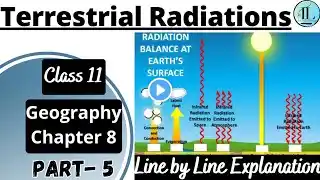
Class 11 Geography Chapter 8 Solar Radiation, Heat Balance, and Temperature |Full Explanation| P1
Welcome to today’s video on Class 11 Geography, Chapter 9 – "Solar Radiation, Heat Balance, and Temperature." In this video, we’ll dive into the fascinating world of how the Sun’s energy affects our planet, governs temperature variations, and establishes the Earth’s heat balance. Key Topics Covered in This Video: Solar Radiation and Its Importance The Sun is the primary source of energy for all life on Earth, and we’ll explain how solar radiation reaches us through various forms of energy waves, such as visible light, ultraviolet (UV) rays, and infrared radiation. We’ll also discuss the role of solar radiation in influencing weather patterns, climates, and ecosystems around the globe. Understanding the Earth’s Atmosphere and Energy Absorption As solar radiation enters the Earth's atmosphere, it encounters various layers that absorb, reflect, and scatter energy. This process is crucial because it determines how much energy reaches the Earth's surface. We’ll go over the mechanisms of absorption, reflection, and scattering, and how they help maintain the Earth's energy balance. Heat Budget and Energy Distribution Ever wonder why some places are hot while others remain cool? This section breaks down the concept of the heat budget, where we examine how the Earth absorbs and re-radiates energy. We’ll discuss the role of convection, conduction, and radiation in distributing heat within the atmosphere, oceans, and land. Additionally, we’ll explain the terms "net radiation" and "heat balance" and explore how the Earth’s surface and atmosphere work together to maintain a stable climate. Temperature and Its Factors Temperature isn’t the same everywhere, and we’ll explore the factors that influence it. Latitude, altitude, distance from the sea, ocean currents, and land-water heating differences all play a role. Understanding these factors will give us insight into why tropical areas are warmer than polar regions, and how factors like altitude make mountainous areas cooler than plains at the same latitude. Diurnal and Seasonal Variations in Temperature We’ll also dive into diurnal (day-night) and seasonal (summer-winter) temperature variations, discussing why temperatures change over a 24-hour period and throughout the year. We’ll explore how Earth's tilt and rotation influence these temperature changes and create distinct climate zones. Global Warming and the Greenhouse Effect Finally, we’ll cover how human activities impact the Earth's heat balance and temperature through greenhouse gases, leading to global warming. This is an essential topic as it ties into environmental studies and current events. We’ll explain how the greenhouse effect, though natural, is intensified by human actions and what it means for our planet’s future. Conclusion: By the end of this video, you’ll have a solid understanding of the key concepts in solar radiation, the Earth’s heat budget, temperature variation, and how these processes impact life on Earth. Whether you’re preparing for exams or just curious about Earth science, this video will provide you with clear and comprehensive insights. Don’t forget to like, subscribe, and comment if you found this explanation helpful!



















